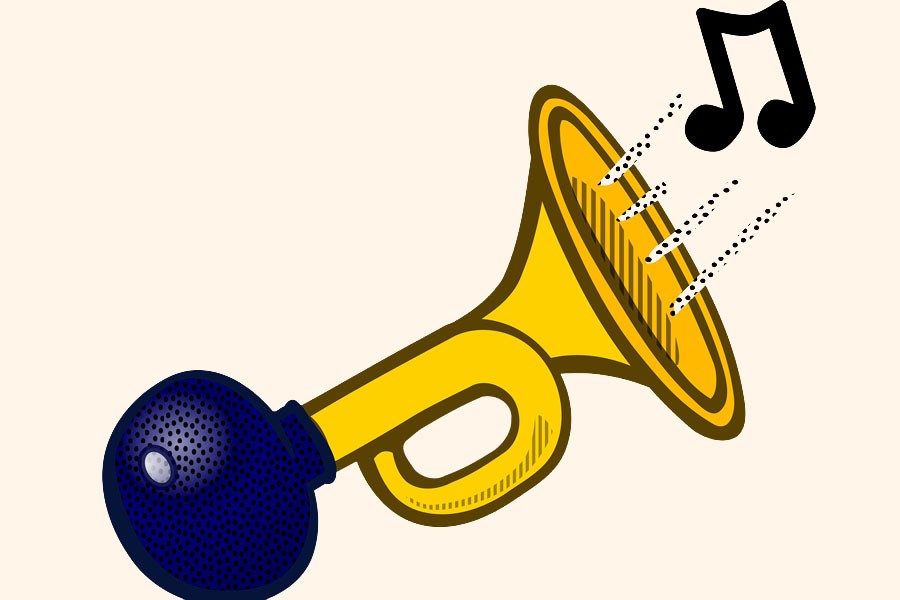
Published :
Updated :

For the residents of Dhaka city, ‘tranquillity’ is a non-existent word. And for those who have to travel by the streets of Dhaka on a regular basis, issues like severe headaches and migraine are common.
Traffic horns in general are quite detrimental to the overall ambience of the roads. It is necessary in some cases but if you observe a busy Dhaka street, you’ll be astonished and irritated to find out that honking is unnecessary most of the time.
What exactly is the impact of traffic horns in Dhaka streets is quite difficult to find due to the lack of such research conducted here. But recent research conducted on neighbouring country’s Nagpur city might help us assume what the conduit of Dhaka might be.
It showed that honking brought an additional 2 to 5 dB (A) noise in the environment, which is quite significant in every possible measure.
This amount of additional noise can be quite detrimental to the environment as it can cause various hearing-related complexities in people.
Although considering this estimate, the condition of Dhaka would be even worse, as Dhaka is a bigger and more populated city compared to Nagpur.
The city dwellers living in the busiest parts of the capital are generally the victims of this traffic horn pandemic.
Fahim Shahriar Priyo, an Economics major from the University of Dhaka–who regularly has to cross Motijheel–the busiest financial hub of the capital, finds life quite difficult out there due to honking.
"Sometimes, the drivers honk just for the sake of it and without any actual utility. And other times, it is done in order to assert their dominance on the road. Using the traffic horn rightfully is something you won't see much, especially in Motijheel,” said Fahim.
“I have to go through Motijheel every day and that's the scariest part of my journey. Sometimes, the sound is so intense that it feels like my brain is exploding."
Talking to the writer, Biddut Chandra Sarker, a lecturer at Environmental Protection Technology at the German University of Bangladesh, termed noise as an insidious threat.
"Shrill traffic horns represent an important environmental risk factor in mechanised areas and it is one of the fastest-growing and most ubiquitous types of environmental pollution.”
He brought up the case of hydraulic horns, which are banned yet ubiquitous.
“Bangladesh Environment Conservation Rules 1997 ensures the standard limit of sound in residential and commercial areas but who cares!"
Mr Sarker also emphasised how noise pollution can be detrimental to the animal population of a particular area.
"Researchers say noise pollution can interfere with breeding cycles and rearing and is even hastening the extinction of some species.”
A report published in the Biology Letters journal of the Royal Society found that noise pollution threatens the survival of more than a hundred exclusive animal species.
“As animals rely upon the sound for everything - from finding a mate to migrating to searching to avoid predators, study after study are revealing how man-made noise is making life more depressing for everybody else than we previously thought. Traffic noise raises the heart rates of butterflies and caterpillars," explained the environmentalist.
Noise pollution in places like Dhaka can be regarded as one of the principal reasons for which it ranks amongst the worst cities in the world to live in.
"When we look at the healthiest ecosystems that exist nowadays on our planet, we are finding that they are also the quietest places. In future, it is required to work on lowering the vehicular sources of environmental noise via developing low noise generating vehicles,” added Mr Sarker.
He also points out some solutions - “Furthermore, proper urban planning can help create ‘no-noise’ zones, in which honking and commercial noise aren't tolerated. Replacing conventional asphalt with extra efficient options, banning hydraulic horns strictly and using proper noise absorbents in motor vehicles also can help lessen traffic noise."
Although some places in Dhaka were free from this pandemic, due to a lack of monitoring, they are quickly catching up. Iftekharul Islam, a resident of Capital's Khilgaon told the writer,
"In my childhood, Khilgaon didn’t have this many people, hence we didn’t have to see traffic jams much and we were not much concerned about the shrill noise coming from traffic vehicles as they were quite low in number.”
“But this has risen exponentially in the recent past due to the fact that Khilgaon is quickly catching up with the most developed parts of Dhaka, leading to an overall increase in traffic which has been largely detrimental for our sleep."
However, awareness is growing. A lot of localities are implementing no honking policies in order to decrease the overall negative impacts of noise coming from vehicles.
Jayedul Islam Antor, living in a residential area near the Dhaka Cantonment told the writer,
"Recently the use of traffic horns and honking has been limited to our residential area as they have been a source of much discomfort to the people living there. I think a lot of residential areas are taking up these policies for themselves which in turn would reduce the traffic horn pandemic in Dhaka to a huge extent."
The excessive and unnecessary use of traffic horns is overall harmful to any society and locality of the world.
And for a densely populated and crowded megacity like Dhaka, the problem seems even more intense. To come up with a comprehensive solution in this matter, the relevant authorities, as well as the people of the city, should work together.
rassiq.aziz@gmail.com


 For all latest news, follow The Financial Express Google News channel.
For all latest news, follow The Financial Express Google News channel.